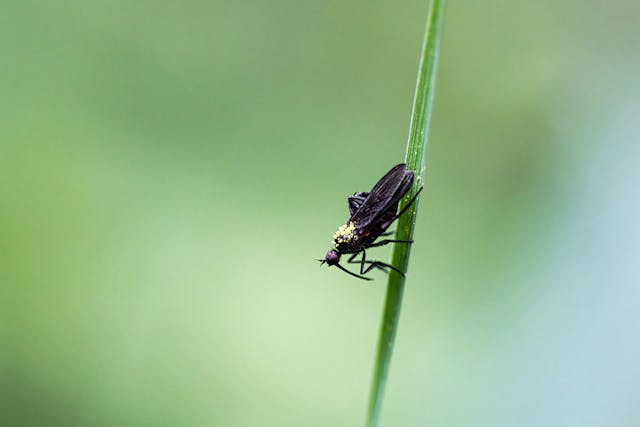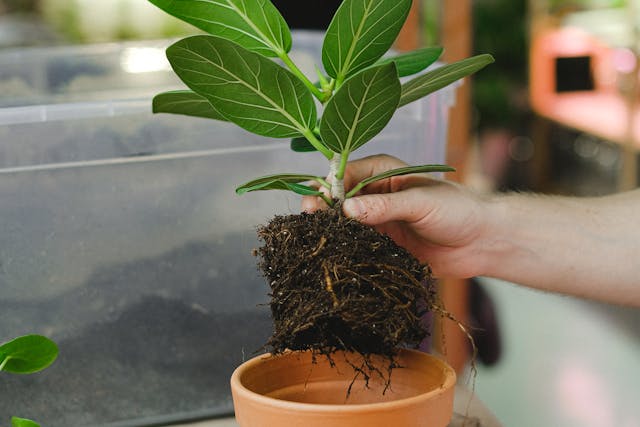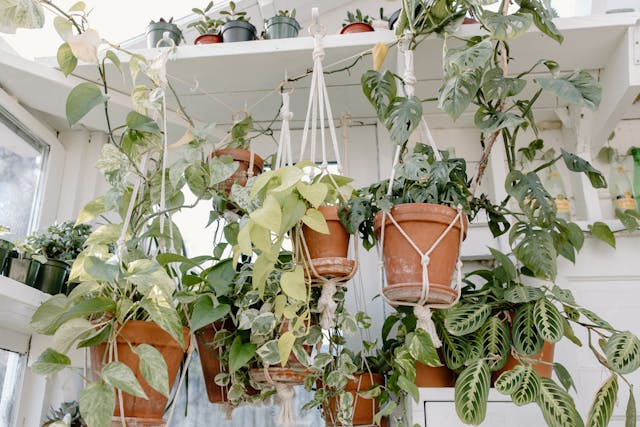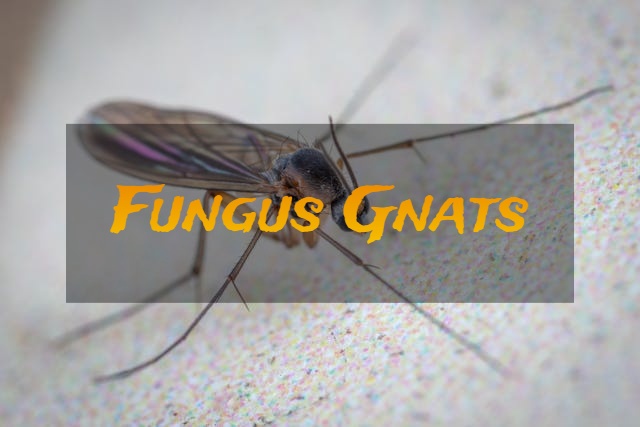Fungus gnats are one of the most annoying pests for indoor plant owners. These tiny, flying insects seem to appear out of nowhere, swarming around your plants and laying eggs in the soil. The worst part? Their larvae can damage plant roots, stunt growth, and even kill your plants if left unchecked.
But why do fungus gnats keep showing up in your home? The truth is, that certain plant care mistakes create the perfect conditions for them to thrive.
In this ultimate guide, we’ll uncover the top reasons why your indoor plants are attracting fungus gnats and how to get rid of them permanently. By the end, you’ll know exactly how to keep your plants healthy and pest-free.

Fungus gnats (family Sciaridae) are small, dark-colored insects that resemble tiny mosquitoes. They measure about 1/8 inch long and have delicate wings and long legs. They are weak fliers and tend to hover close to soil or crawl on plant leaves.
The Life Cycle of Fungus Gnats
Fungus gnats go through four main life stages:
- Eggs – Laid in moist soil, hatch within 3-6 days.
- Larvae – Tiny, translucent worms with blackheads that feed on plant roots and fungi in the soil for up to 14 days.
- Pupa – The transformation phase where larvae develop into adult gnats (lasting 3-6 days).
- Adult – Winged insects that live about a week, laying up to 300 eggs before dying.
Why Fungus Gnats Are Harmful
- Root Damage – Larvae chew through fine roots, stunting plant growth.
- Weakened Plants – Infested plants often wilt and struggle to absorb nutrients.
- Fast Reproduction – A single fungus gnat can lay hundreds of eggs, making infestations difficult to control.
Now that we understand their behavior, let’s dive into the reasons why your indoor plants are attracting fungus gnats and how to stop them.
Overwatering: The Biggest Culprit Behind Fungus Gnat Infestations
Why Overwatering Attracts Fungus Gnats
Overwatering is the #1 reason fungus gnats infest indoor plants. These pests thrive in moist soil, and excessive watering keeps conditions perfect for them to reproduce.
When soil remains wet for too long, it encourages fungal growth, which serves as food for gnat larvae. Additionally, continuously damp soil prevents oxygen from reaching plant roots, making them susceptible to decay—another attraction for gnats.
How to Prevent Overwatering
- Follow the Finger Test – Stick your finger about an inch into the soil. If it’s dry, water your plant.
- Use a Moisture Meter – A digital soil moisture meter can help monitor soil dampness.
- Water Less in Winter – Indoor plants require less water in colder months.
Poor Drainage: Creating a Breeding Ground for Fungus Gnats
How Poor Drainage Contributes to Infestations
Even if you’re not overwatering, poor drainage can trap excess moisture in the soil, leading to stagnant water—the perfect place for fungus gnat eggs to hatch and larvae to thrive.
When plant pots don’t have proper drainage, water accumulates at the bottom, keeping the soil too moist for too long. This not only suffocates plant roots but also creates an ideal breeding ground for gnats.
How to Improve Drainage
- Use Pots with Drainage Holes – If your pots don’t have drainage holes, the excess water has nowhere to escape, leading to damp soil constantly. Always use pots with proper drainage holes.
- Choose Well-Draining Soil – A good potting mix should contain perlite, sand, and peat moss to prevent soil compaction and improve aeration.
- Add a Layer of Pebbles or Gravel – Placing a layer of pebbles at the bottom of your pot can help excess water drain more efficiently.
- Avoid Using Saucer Trays Incorrectly – If using a saucer tray to catch excess water, make sure to empty it after watering to prevent standing water.
Organic Matter Buildup: A Buffet for Fungus Gnat Larvae
Why Decomposing Organic Matter Attracts Fungus Gnats
Fungus gnat larvae feed on decaying plant material in the soil. If you have a buildup of dead leaves, rotting roots, or organic debris, your plant pots become a buffet for fungus gnat larvae.
How to Prevent Organic Matter Accumulation
- Remove Fallen Leaves and Debris Regularly – Check your plant’s soil weekly and remove any decaying leaves or organic matter.
- Use Sterilized Potting Mix – Some homemade composts may contain fungi and bacteria that attract gnats. Always use sterilized, store-bought potting soil for indoor plants.
- Trim Dead or Dying Roots – If repotting a plant, check for rotting or mushy roots and trim them off before placing the plant in fresh soil.
Using Infected Soil: How Contaminated Potting Mix Invites Fungus Gnats
How Fungus Gnats Can Enter Your Home Through Soil
Sometimes, the source of a fungus gnat infestation is the soil itself. Many store-bought potting mixes already contain fungus gnat eggs or larvae, especially if the soil has been stored in humid conditions.
How to Prevent Buying or Using Infected Soil
- Buy High-Quality Potting Soil – Choose reputable brands that offer sterilized soil to reduce the risk of contamination.
- Heat-Treat Your Soil Before Use – To kill potential eggs or larvae, you can bake soil in the oven at 180°F (82°C) for 30 minutes before using it.
- Store Potting Soil in Airtight Containers – Once opened, keep the soil sealed in a container to prevent pests from infesting it.
Lack of Air Circulation: The Hidden Reason Your Plants Attract Fungus Gnats
How Poor Air Circulation Encourages Fungus Gnat Infestations
Fungus gnats prefer stagnant, humid environments. If there is little to no airflow around your indoor plants, moisture in the soil evaporates more slowly, allowing it to stay damp—perfect for gnat breeding.
How to Improve Air Circulation
- Use a Small Fan – Place a gentle fan near your plants to increase airflow and dry the soil faster.
- Space Out Your Plants – Avoid crowding multiple plants together, as this can trap moisture and create a humid microclimate.
- Open Windows and Doors When Possible – Fresh air helps regulate humidity levels and discourages gnats from settling in.
Excess Humidity: How a Moist Environment Encourages Fungus Gnat Growth
Why High Humidity Attracts Fungus Gnats
Fungus gnats thrive in high-humidity environments because moisture keeps the soil damp, allowing their larvae to survive and feed easily. If your indoor space has poor ventilation and excessive humidity, your plants become a prime target for gnats.
How to Reduce Indoor Humidity
- Use a Dehumidifier – If your home is naturally humid, a dehumidifier can help reduce moisture levels.
- Increase Ventilation – Open windows, use fans or run an air purifier with a dehumidifying feature.
- Water Plants in the Morning – This allows moisture to dry throughout the day, preventing excess humidity buildup.
Decaying Roots: A Silent Invitation to Fungus Gnats
How Root Rot Attracts Fungus Gnats
When plant roots start to rot, they release moisture and decay, creating the perfect food source for fungus gnat larvae. If you frequently overwater or have poor drainage, your plant’s roots may be rotting without you realizing it.
How to Prevent Root Rot
- Check Roots When Repotting – Look for mushy, brown, or black roots and trim them off.
- Use Well-Draining Soil – Prevent water from sitting in the root zone by using a light, airy potting mix.
- Let Soil Dry Between Waterings – Only water when the top inch of soil feels dry to the touch.


Overcrowding Plants: How Dense Foliage Creates a Gnat Paradise
Why Dense Plant Groupings Attract Fungus Gnats
When multiple plants are grouped too closely together, air circulation decreases, and humidity rises, creating ideal conditions for fungus gnats to thrive.
How to Avoid Overcrowding Issues
- Give Plants Enough Space – Ensure that air can flow freely between each plant.
- Trim Dense Foliage Regularly – Remove excess leaves to improve ventilation.
Lack of Natural Predators: Why Fungus Gnats Thrive Indoors
Why Fungus Gnats Multiply Indoors So Quickly
In outdoor environments, natural predators like spiders, predatory mites, and certain beetles keep fungus gnat populations in check. But indoors, these natural controls don’t exist, allowing infestations to grow rapidly.
How to Introduce Natural Predators Indoors
- Use Beneficial Nematodes – These microscopic worms kill fungus gnat larvae in the soil.
- Introduce Hypoaspis Miles (Predatory Mites) – These mites feed on gnat larvae, reducing infestations naturally.
Organic Mulch: A Double-Edged Sword for Indoor Plants
How Organic Mulch Can Attract Fungus Gnats
Mulching is an excellent way to retain moisture and add nutrients to the soil. However, organic mulch like bark, coconut husk, or wood chips can create the perfect habitat for fungus gnats.
Why? Because organic materials break down over time, producing decaying matter that fungus gnat larvae love to feed on. Additionally, mulch traps moisture, keeping the soil damp—another condition in which gnats thrive.
How to Use Mulch Without Attracting Fungus Gnats
- Use Inorganic Mulch – If you want to retain moisture without inviting gnats, consider gravel, pebbles, or sand as mulch alternatives.
- Avoid Thick Mulch Layers – A thick layer of mulch traps moisture, so use a thin layer (no more than ½ inch).
- Let the Top Layer of Soil Dry – Before adding mulch, make sure the topsoil isn’t constantly damp.
Fertilizer Overuse: How Nutrients Can Attract Fungus Gnats
Why Over-Fertilizing Encourages Fungus Gnats
Excess fertilizer can cause fungal growth in the soil, which in turn attracts fungus gnats looking for a food source. Additionally, high nitrogen content promotes rapid plant decay, leading to rotting roots that gnats love.
How to Prevent Fertilizer-Related Fungus Gnat Infestations
- Use Slow-Release Fertilizers – These reduce the risk of nutrient overload and fungal growth.
- Avoid Over-Fertilizing – Follow recommended dosages and fertilize only during the growing season.
- Flush Soil Periodically – Rinse soil with water every few months to remove excess salts and organic buildup.
Neglecting Plant Maintenance: A Recipe for Pest Infestation
How Poor Plant Care Leads to Fungus Gnats
If you don’t regularly care for your plants, they become more susceptible to pests, root rot, and fungus gnat infestations. Neglected plants often have:
- Decaying leaves
- Compact soil that retains too much moisture
- A buildup of organic debris
How to Maintain Your Plants to Keep Fungus Gnats Away
- Prune Dead Leaves & Stems – Remove yellowing or dead leaves to prevent decay.
- Aerate the Soil – Occasionally stir the topsoil to break up compacted areas and improve drainage.
- Clean Plant Pots Regularly – Rinse pots before repotting to prevent soil contamination.
Solutions: How to Get Rid of Fungus Gnats Permanently
If you’re already dealing with a fungus gnat infestation, don’t worry! Here’s how to eliminate them once and for all.
Related Article: Get Rid of Gnats Indoor Plants
1. Let the Soil Dry Out
Since fungus gnats thrive in moist soil, the simplest solution is to let the top 1-2 inches of soil dry completely before watering again. This kills gnat larvae and prevents new eggs from hatching.
2. Use Sticky Traps
Yellow sticky traps are a great way to catch adult fungus gnats and reduce their population. Place traps near the soil surface to target flying gnats.
3. Apply Neem Oil or Hydrogen Peroxide Solution
- Neem Oil Spray – Neem oil disrupts the gnat life cycle and prevents them from reproducing.
- Hydrogen Peroxide Solution – Mix one part hydrogen peroxide (3%) with four parts water and pour it into the soil. This kills larvae instantly.
4. Introduce Beneficial Predators
- Hypoaspis Miles (Predatory Mites) – These mites eat gnat larvae in the soil.
- Beneficial Nematodes – Microscopic worms that attack fungus gnat larvae naturally.
5. Use Sand or Gravel as a Soil Topper
Adding a thin layer of sand, perlite, or gravel on top of the soil prevents adult gnats from laying eggs in the soil, breaking their lifecycle.
6. Repot with Fresh Soil
If the infestation is severe, consider removing the plant, rinsing its roots, and repotting in fresh, sterile soil to eliminate fungus gnat eggs and larvae completely.
Conclusion: Keeping Your Indoor Plants Gnat-Free
Fungus gnats can be a frustrating problem, but with the right approach, you can prevent and eliminate them for good. The key takeaways are:
Avoid overwatering – Let the soil dry between waterings.
Improve drainage – Use well-draining soil and pots with drainage holes.
Keep soil clean – Remove dead leaves and organic debris regularly.
Use sticky traps, neem oil, and hydrogen peroxide to kill gnats naturally.
Introduce beneficial predators to control gnat populations.
By following these tips, you can enjoy healthy, thriving indoor plants—without the nuisance of fungus gnats!

